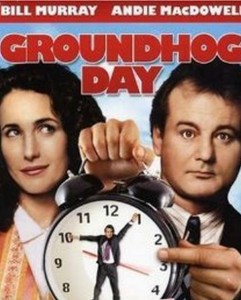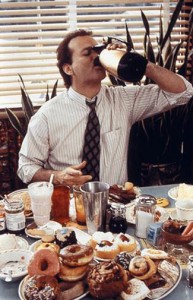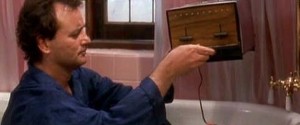100 Film Favorites – #76: Groundhog Day
(Harold Ramis, 1993)
 “That’s right, woodchuck-chuckers. It’s GROUNDHOG DAY!”
“That’s right, woodchuck-chuckers. It’s GROUNDHOG DAY!”
Let me start off by saying I was sorely tempted to feature Groundhog Day as the first entry in this Countdown, and just repeat the exact same post a hundred times. But you’re probably glad I didn’t do that.
I repeat: I did not do that. If you HAVE seen this same post pop up 100 days in a row, I hate to break it to you, but you may be stuck in a personal time loop. Good luck with that.
 Groundhog Day stars Bill Murray as Phil Connors, a self-centered Pittsburgh weatherman who travels to Punxsutawney with his cameraman and new producer to cover the Groundhog Day festivities, an annual assignment which Phil hates. When an unexpected blizzard makes it impossible for the crew to leave, they are forced to stay in town another night. Phil awakens the “next” morning to find that it is not February 3rd, but the 2nd, Groundhog Day, again. The events of the “previous day” proceed like clockwork, just as they did 24 hours earlier. Phil is the only one who notices anything strange, and because of this is the only one capable of altering the course of the day’s “normal” events. Yet no matter how he acts, every morning Phil wakes up in the same place and time: 6:00 am on Groundhog Day, with Sonny & Cher’s “I Got You, Babe” playing on the radio.
Groundhog Day stars Bill Murray as Phil Connors, a self-centered Pittsburgh weatherman who travels to Punxsutawney with his cameraman and new producer to cover the Groundhog Day festivities, an annual assignment which Phil hates. When an unexpected blizzard makes it impossible for the crew to leave, they are forced to stay in town another night. Phil awakens the “next” morning to find that it is not February 3rd, but the 2nd, Groundhog Day, again. The events of the “previous day” proceed like clockwork, just as they did 24 hours earlier. Phil is the only one who notices anything strange, and because of this is the only one capable of altering the course of the day’s “normal” events. Yet no matter how he acts, every morning Phil wakes up in the same place and time: 6:00 am on Groundhog Day, with Sonny & Cher’s “I Got You, Babe” playing on the radio.
Phil’s “time loop” persists (for anywhere from ten to 10,000 years, according to various estimates by the cast and crew), and he has to find ways to fill an eternity in his new, tiny, never-changing world. This is where the film really shines, and what makes it the hallmark example of the time loop concept in fiction. The film gives Phil time to explore all the possible nuances of his loop, and answers a lot of possible viewer questions in the process. For instance: What happens if Phil goes to sleep somewhere other than his bed? What happens if he kills himself? Does the loop “start over” precisely at midnight?
 Phil’s outlook on his situation gradually changes, and through his experience we see the many possible pros and cons of the time loop scenario. Initially aggravated and incredibly bored with the incessant repetition, Phil suddenly realizes the incredible possibilities of having no consequences. He turns toward hedonism, seducing women without having to worry about the “morning after,” and eating massive feasts without gaining an ounce. When this too grows dull, Phil attempts to establish a more meaningful relationship with Rita, his new producer, in whom he has become interested. Day in and day out, Phil learns tiny bits of information about Rita, taking copious mental notes. Each time the cycle repeats, Phil is able to woo Rita more successfully with his increasing knowledge of her. This only takes him so far, however, and while a handful of evenings end favorably for him, more often than not he winds up slapped in the face. And all the while, the day keeps looping.
Phil’s outlook on his situation gradually changes, and through his experience we see the many possible pros and cons of the time loop scenario. Initially aggravated and incredibly bored with the incessant repetition, Phil suddenly realizes the incredible possibilities of having no consequences. He turns toward hedonism, seducing women without having to worry about the “morning after,” and eating massive feasts without gaining an ounce. When this too grows dull, Phil attempts to establish a more meaningful relationship with Rita, his new producer, in whom he has become interested. Day in and day out, Phil learns tiny bits of information about Rita, taking copious mental notes. Each time the cycle repeats, Phil is able to woo Rita more successfully with his increasing knowledge of her. This only takes him so far, however, and while a handful of evenings end favorably for him, more often than not he winds up slapped in the face. And all the while, the day keeps looping.
Phil then sinks into depression, and tries numerous ways of committing suicide. However, he finds that killing himself simply makes the day begin again all the sooner for him.
Phil ultimately decides to spend his cyclical eternity learning new things, as well as bettering himself and his new-found community. He learns French, Italian, ice sculpting, and the piano, and even claims to have spent an entire six months learning how to precisely toss playing cards across a room into a hat. Meanwhile, he learns the habits and entire life stories of everyone in the town, and begins to use this information to help them where he can (rescuing a boy who falls from a tree, replacing a flat tire for a trio of old ladies, employing the Heimlich on a portly choking man, etc.) Eventually, on a particularly perfect iteration of Groundhog Day, Rita is so taken with the new generous, helpful, and erudite Phil that she “buys” him at a bachelor auction (against stiff competition from the three old ladies). They spend the evening, and then the night, together and Phil remarks that “No matter what happens tomorrow, or for the rest of my life, I’m happy now.”
The next morning, he and Rita awaken on February 3rd.
Groundhog Day is very funny, but its true strength lies in the way it depicts Phil’s character arc and the changing views with which he faces his 24-hour eternity. The film is unafraid to be quite dark at times, but the message that we can (indeed, must) better ourselves as people to truly achieve contentment is ultimately an uplifting one. It’s the kind of movie you can enjoy again and again
and again…
and again…
and again…
P.S. – I feel another important aspect of the film’s effectiveness has to do with its use of music. The two pieces with which Phil starts every day (“I Got You, Babe” on his radio alarm clock and “The Pennsylvania Polka” at the Gobbler’s Knob fairgrounds) grow more grating and annoying with every repetition, with the polka piece an especially humorous choice, as the townspeople gallivant and celebrate around the perpetually irritated Phil. Try listening to it on repeat for 10,000 years and see whom you side with.
—
Brian Terrill is the host of television show Count Gauntly’s Horrors from the Public Domain. You can keep up with Brian’s 100 Film Favorites countdown here.







